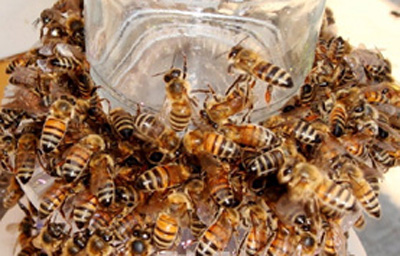The finding shows that bee colonies behave more like giant, single beasts than as individual insects.
 THE GIST:
THE GIST:
0 Bees can tell others in their colony to avoid troublesome places.
0 This is the first time a “negative” bee signal has been identified.
0 The bees doing the warning can target the bees who are “dancing” directions.
Honeybees don’t only waggle dance to tell hive-mates the whereabouts of good eats, they also bump and beep to warn others when big trouble awaits at some of those floral diners.
The discovery of the “stop” signal is the first negative or “inhibitory” message ever found in bees.
Previously the only recognized messages were all “excitatory” and about how good and where the nectar was at various locations relative to hive.
“Originally people called it a begging signal,” said bee researcher James Nieh of the University of California at San Diego, regarding what was for 20 years considered a mysterious behavior. “It’s usually produced by butting the head and giving a short beep” to another bee that is in the middle of providing information to the hive about a specific feeding site.
Closer inspection showed that the signal was never actually followed by any food being given, which nixed the begging hypothesis.
Another researcher thought perhaps this had something to do with overcrowded feeding areas, said Nieh. But others saw the same behavior in uncrowded hives as well.
“That got me thinking about what there could be in common,” Nieh told Discovery News “What if they were being attacked?”
So Nieh and his assistants devised a series of experiments to simulate attacks by predatory crab spiders or by bees from competing colonies.
“In all causes we found yes, they all significantly increased ‘stop’ signals,” Nieh confirmed. His results are reported in the Feb. 23 issue of the journal Current Biology.
What’s more, the bees delivering the stop signals are not wasting time: They target the message directly at those bees that are trying to recruit for the specific locations where the attacks are happening, said Nieh. They do this, as their experiments confirmed, by identifying odors that the bees got from those specific locations, he explained.
“It’s pretty cool to see,” said Cornell University swarm intelligence researcher Thomas Seeley. “It looks like it has to be a very negative experience to put these signals out.”
The discovery of the bee “stop” signal may or may not have practical applications in fruit orchards and other places where honeybees are vital pollinators. What the finding really does is add a new wrinkle in the science of superorganisms.
“This is really the second example of a negative feedback in a superorganism.” Nieh said. The other is in Pharaoh ant colonies, where ants can re-designate pheromone trails with a scent that says “Don’t follow this trail!” when the way is no longer safe or worthwhile.
The negative signals the bees and ants brings them that much closer to operating exactly like multicellular organisms — which use positive and negative feedback signals all the time between cells.
A good example in the human body is among retinal cells in the eye, noted Seeley. When a retinal cell detects a strong light, it will inhibit the responses of cells around it. That enhances our ability to distinguish sharp edges, he said.



